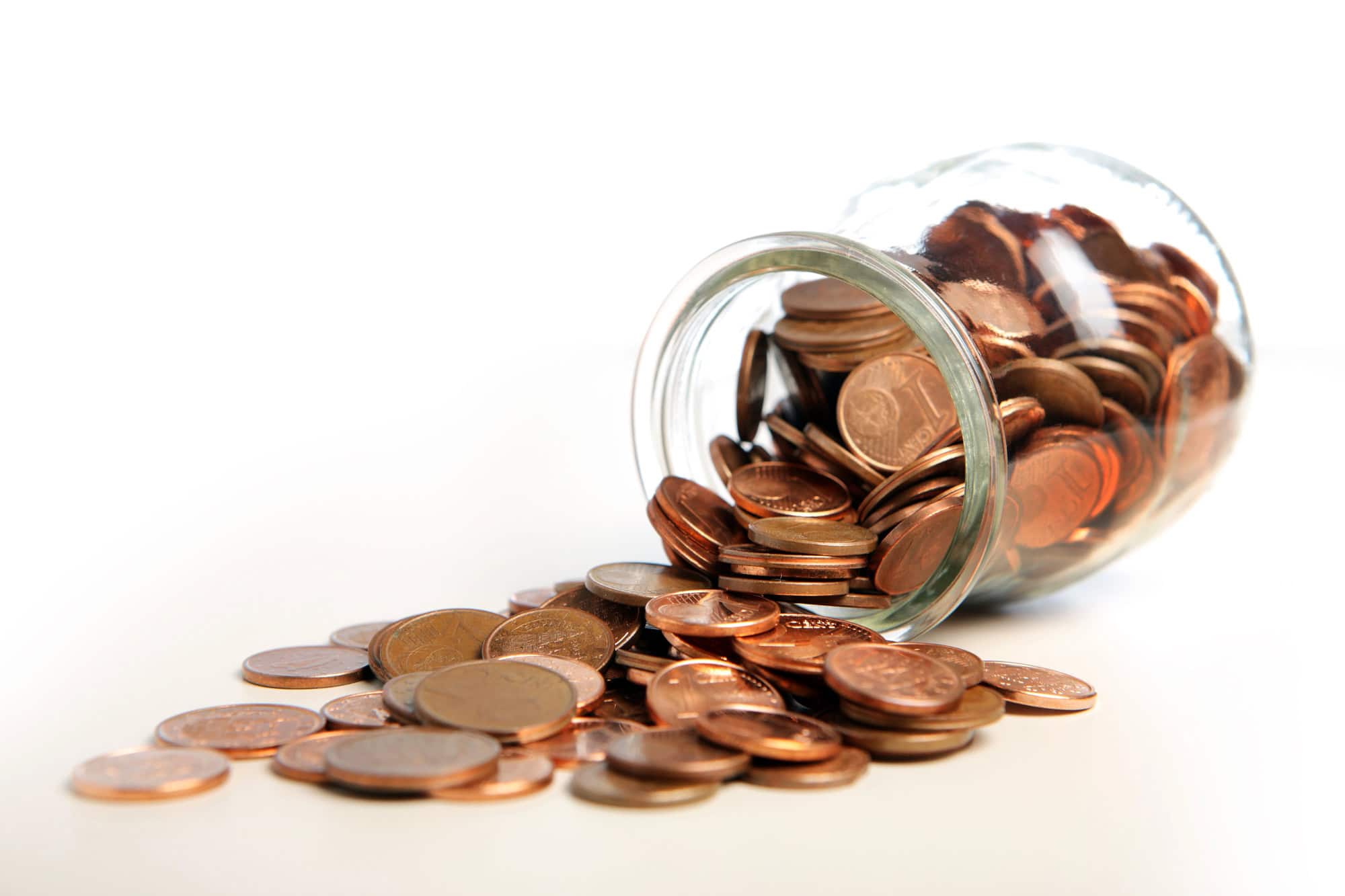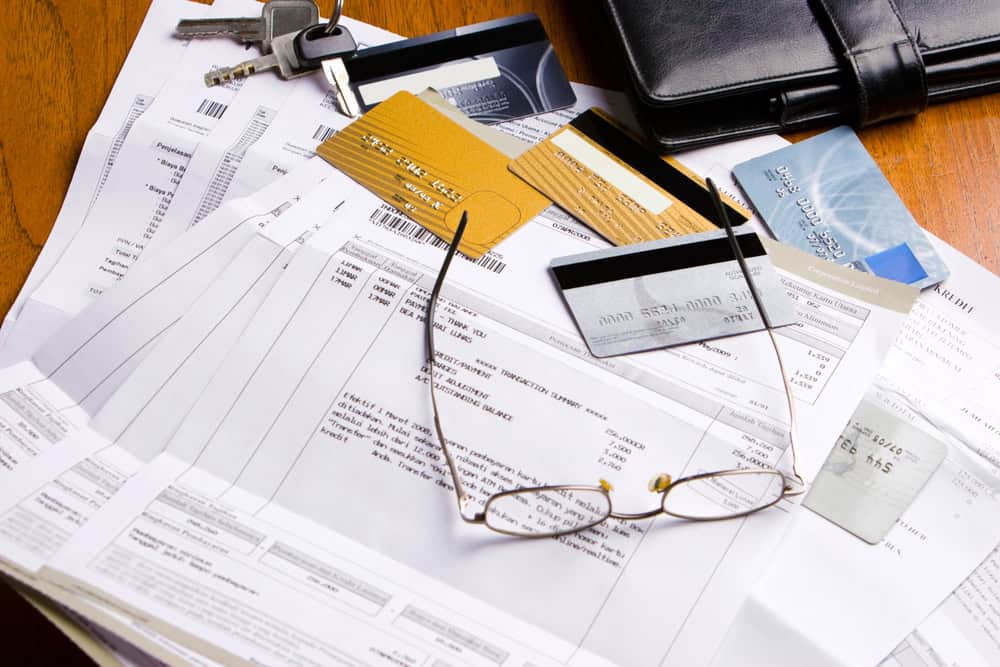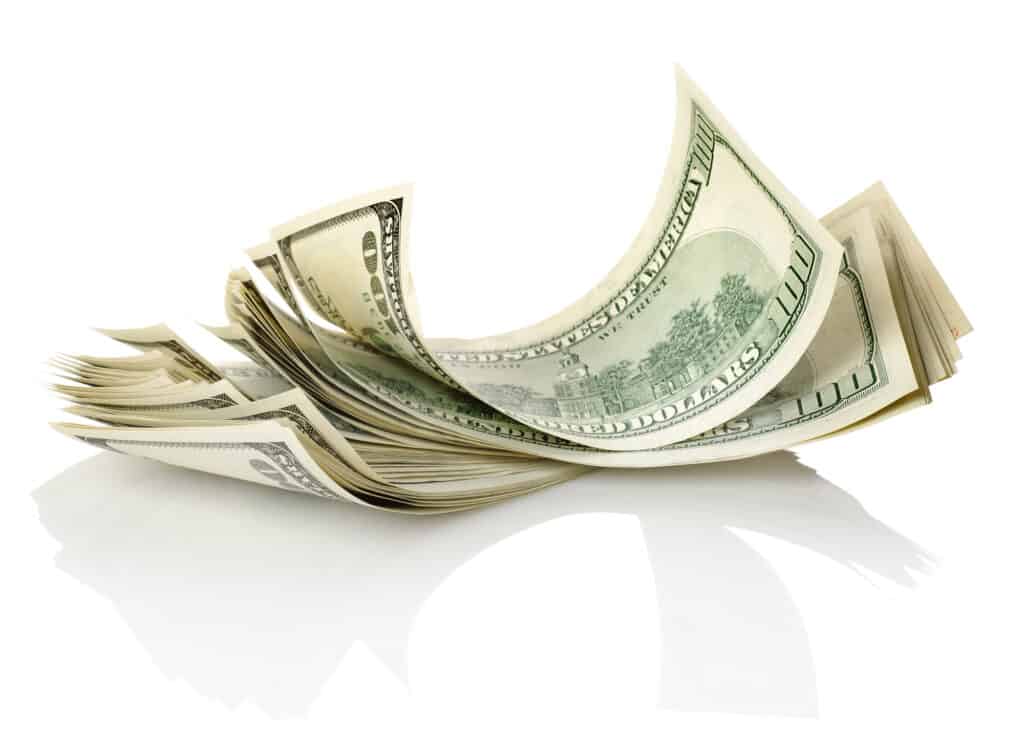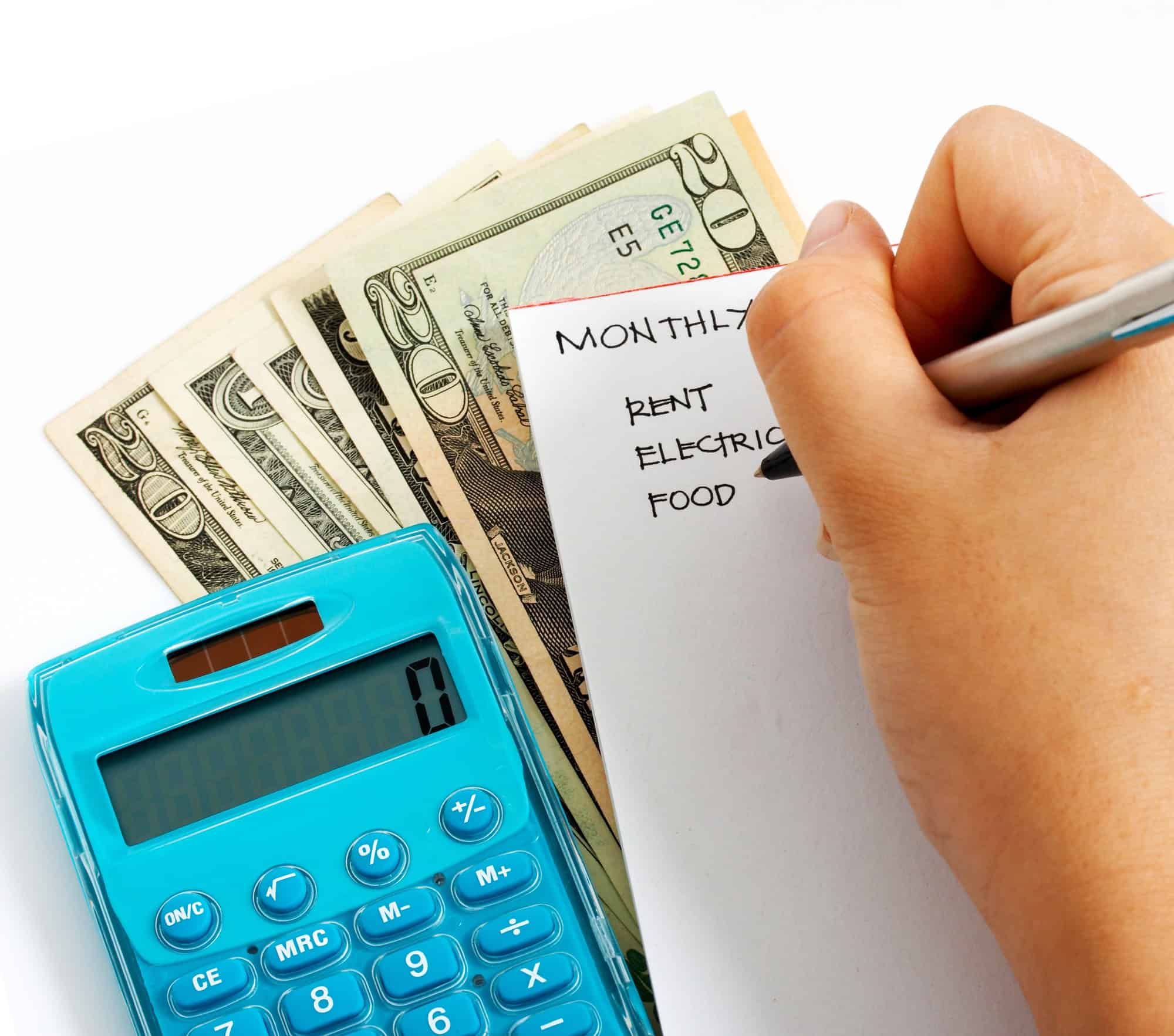Struggling to save money? You are not alone. The Federal Reserve reports that 39% of Americans wouldn’t be able to handle a $400 emergency and 56% of Americans have less than $5000 in their savings account.
Between high housing costs, rising inflation and limited income, trying to find money to put toward retirement savings or a short term goal can feel like a Herculean task!
But let’s talk about some simple tips to living on a tight budget and saving money.
Table of Contents
How to Save Money on a Tight Budget

01. Understand Your Financial Situation
One of the very first places to start when managing your money (regardless of your income level) is by getting yourself organized and understanding your exact financial situation.
Take a look at bank statements, check bank balances and any cash you have on hand.
Next, make a separate list of your total household income, especially if your monthly income comes from multiple sources.
Finally, make a third list of all your daily expenses, if you have subscription service, outstanding debt like student loans or mortgage payments, and other monthly expenses.
Another option when combining all your financial information together is to utilize a budget calendar. You simply print a blank calendar or utilize a digital one and plot all your income and expenses for the month.
If you can compile all of this information together, it’ll give you a great overhead look at exactly what you have obligated and ideas of where you may be able to make changes.

Grab Your Free Budgeting Calendar & Checklist Now!
Give complicated systems a hard pass and start getting your money organized and create a budgeting plan that works for you!
Downloaded by over 10,000 busy budgeters just like you!
02. Conduct an Audit of All Expenses
The goal here is not necessarily to nickel and dime yourself into misery, but rather to inspect what you are spending your money on and if those purchases are pushing you toward your financial goals and if they align with your financial priorities.
You are really analyzing to determine if it’s a value add item.
That subscription to Disney + provides hours of low cost entertainment and happiness each week for your family– is that of value to you?
That subscription to House Beautiful magazine that get’s a cursory 20 second look over before getting tossed on a table– is that of value to you?
You are the expert on your finances.
Go through line by line.
If you are feeling a bit extra you can even make a running list as you go through as to which expenses you want to: Keep, Lower, or Cancel.
Then by the end of the audit you’ll have a bit of an action plan already put together.

03. Lowering Expenses
For many families, expenses are directly proportional to income. And if you utilize a zero-based budget, as your income increases, it’s possible that lifestyle inflation has also been inflating your expenses as well.
So now that you’ve conducted your spending audit, it’s time to take a look at the budget categories that you want to lower or cancel all together or some strategies to get there.
Grocery Budget
Money on groceries is easily one of the highest variable expenses in any budget.
Rising inflation may be a contributing factor, but lacking a plan and strategy can also effect this necessary budget category.
Meal planning is a great first step when you are trying to wrangle in your food spending.
When you plan out your meals for the week, not only does it alleviate the stress of figuring out every day, “What’s for dinner?”, but it also allows you to shop with strategy and intention.
You can plan meals around what you already have on hand in your pantry and freezer as well as taking advantage of your local grocer’s sales which can definitely save you a bit of money.
Cell Phone Plan
Be sure to check the line itemization on your cell phone bill.
There may be services there that you aren’t using, or a way to cut back.
With the prevalence of working from home jobs and remote working, many cell phones have the ability to make calls using wifi. If you are in that situation, you may be able to get by with a smaller cell phone package.
Another option here would be to research deals and promotions from your cell phone provider’s competitors to leverage a lower rate.
Also be sure to checkout discount cell providers like Mint Mobile, who at the time of this writing has unlimited talk/text + 4GB of data for just $15/month. Thats a pretty budget friendly deal!
Utility Bills
Utilities are a necessary part of renting or owning your own home. But just because they are necessary doesn’t mean there aren’t ways to save on energy costs, heating bills, water, and more!
Here are some quick ways to save money fast on your utilites:
- Switching to a programable thermostat to raise/lower the temperature while you are out of the house.
- Keeping up with changing your air filters.
- Opt in for budget utilities. Instead of having variable utility costs, utility companies take an average so you have an easier fixed bill to budget– just call customer service to inquire. (Usually there is a bill at the end of the year that accounts for the over and under of charges).
- Seal up holes and air leaks. Invest in draft dodgers for the bottom of your doors if your doors don’t seal well.
- Take shorter showers.
- Raise the thermostat on your hot water heater.
Fun Money
Fun money refers to money set aside in your budget for fun and entertainment.
I’ve found that cutting fun money out of a budget completely often leads to a busted budget as it’s so hard to live such a restricted lifestyle long term.
The key here is not that it’s necessary to cut these expenses out of your budget completely, but more that we need to be more intentional in these areas.
Streaming services, cable plans, and magazine subscription services are all monthly spending that needs to be carefully evaluated to see just where you want your fun money allocated.
If these are areas you want to cut back, consider cheaper alternatives to cable, such as reading a book or borrowing movies from your neighborhood library.
Negotiate Insurance
If you have a solid track record with your auto insurance (both in terms of driving and payments) it is definitely worthwhile to reach out and see what they can do in terms of a better rate.
Some insurance companies even offer multi-driver discounts, discounts for safe drivers, and long term customer discounts.
If any of these apply to you, give your insurance company a call. You’ll never know until you ask!
Fees
Banking Fees and credit card fees These can really quickly eat into your monthly budget and with no other reason that for doing business with a particular company.
If you aren’t sure if any of these apply to you, check your statements. I’ve seen some banks charge as much as $25 a month for using a specific checking account and credit card companies sometimes asses annual fees as well.
This small change has the potential to save you hundreds of dollars a month.
Check out these great free checking account options.
Streamlining
You could also consider consolidating or combining services.
Instead of paying for an additional streaming service, if you are already Amazon Prime, there is a library of movies included inside that service you are already paying for.
Another option to look at is your cell service provider. With our cell plan, we get Netflix included within our plan, which allows us to allocate that money else where.
Downsizing
When you are struggling to make ends meet, you have two options: make more money or cut back expenses.
is definitely a viable option if you are struggling to meet all your financial obligations.
Replace your car with a cheaper one, or move to a smaller apartment.
Downsizing can feel a little intimidating or perhaps a little extreme, but housing (and it’s subsequent utilities) are often one of the biggest and most expensive budget categories for many families.
Obviously it’s important to weigh your options and the cost effectiveness of such a move, but it’s definitely worth considering.

Grab Your Free Budgeting Calendar & Checklist Now!
Give complicated systems a hard pass and start getting your money organized and create a budgeting plan that works for you!
Downloaded by over 10,000 busy budgeters just like you!
04. Create a Budget
Whether you want to go old school with pen and paper, create a spreadsheet or utilize a budgeting app, the important part is to plan out your spending for the month.
A budget doesn’t have to be fancy, it just needs to be effective for you.
You have many options when it comes to how you choose to budget your money:
- You have the 50/30/20 method, where you budget 50% of your income for necessities, 30% for discretionary spending and 20% for savings.
- The zero based budget where you budget all your money down to zero. Leaving no penny unallocated.
- Cash envelope method where you pay your bills using cash envelopes designated for each of your monthly bill categories.
Whatever method you choose, or if you go the DIY route, having a plan for your money is the primary goal here.

05. Paying off debt
Paying off (or down!) credit cards, student loans, and personal loans is a big step towards saving money in your financial journey.
High-interest debt has the potential to eat away hundreds of dollars each month in interest alone.
If you are looking for an easy to implement strategy to shed debt, a super effective approach s the Debt Snowball method.
The Debt Snowball Method is a debt-reduction strategy wherein debts are prioritized from the smallest to the largest balance.
To start out, you figure out how much extra money you have to throw at your debt payments.
Next you take your smallest debt balance and apply the minimum payment plus the extra money you have at that debt.
Simultaneously paying just the minimum payments for all your other debts.
Once your smallest debt has been paid in full, you then move onto the next smallest debt– applying the minimum payment from the first debt you paid off, the extra money you have to put toward debt, plus that debt’s minimum payment.
With this method, you can see how you are able to gain momentum in paying for debt every time you knock out a debt.
06. Enter a No-Spend Challenge
A no-spend challenge is a quick way to save money fast.
If you are unfamiliar with a no spend challenge, it’s literally exactly how it sounds, you are creating a challenge for yourself to throw the breaks on everyday spending and impulse buys by freezing your spending to just the necessities and nothing else.
For these challenges, you can either do it over a weekend, week, or a month– whatever feels right to you.
07. Prepare for Budget Busters
When you are on a tight budget it is more important than ever to prepare for unexpected and irregular expenses.
One of the biggest reasons to have sinking funds and an established emergency fund is for areas just like this.
Budget busters refer to expenditures from unforeseen events or expenses that don’t come around regularly– such as job loss, health problems, home repairs, car repairs, major purchases and the like.
Creating a plan before these expenses arrive is a solid step in preparing for those unexpected financial surprises.

08. Switch to Cash
While carrying cash may feel old fashioned there are several studies showing that spending cash can lead to spending less money. Chiefly as it’s tangible and you can literally see it leaving your wallet, not to mention you can literally see the end of what you have in your wallet.
While it may not be practical to make your mortgage payment in cash– covering discretionary spending like gas, groceries and fun money are all certainly good candidates.
While this may not be an obvious money saving tip, it’s certainly an effective one for many families.
Dave Ramsey, a financial expert, made the cash envelope budget method wildly popular.
Cash Envelope budgeting tends to be very effective not just for families on a tight budget, but also for people struggling with overspending.
So whether you decide to go all in with an all cash budget or want to go the hybrid route with a bank account & cash spending– switching to cash may be a great option to gaining control of your spending.
09. Follow the 30 Day Rule
You may be wondering, What is the 30 day rule?
It’s simple, if there’s a purchase you want to make you wait 30 days. If after 30 days you are still interested in the purchase, you can move forward.
However, if once the 30 days is up, you forget about or change your mind, you’ve saved yourself money.
Either way you know that you can make purchasing decisions with confidence — because they have been made with intention and deliberation.
10. Save Money with Rakuten
Rakuten is a free browser based extension that allows you to earn cash back on purchases from over 3,500 retailers.
How does Rakuten work?
Rakuten gets a commission from the stores in their directory and then pass a portion of that commission on to you in the form of cash.
First, you find the store on rakuten.com, click “Shop Now” and shop like normal on the store site. After you make an eligible purchase, you’ll earn Cash Back and get a check or PayPal payment every quarter.
Note: Rakuten also offers a browser extension that you can use that will allow you to earn cash back but also will find coupons you can apply during checkout to save you even more money.
Pretty awesome right? I love Rakuten and have been using it for many many years to save money when shopping online (including travel!).
How to get started with Rakuten?
- Sign up for free.
- Shop with Rakuten at your favorite stores.
- Earn Cash Back on your orders.
- Get paid by check or PayPal — no fees, no forms!

11. Comparison Shop
One of the easiest ways to make money is by checking around and comparing prices on items you use the most.
It can be as simple as keeping a small notebook with price lists or as techie as using an app or spreadsheet to track.
In my local area, the difference between shopping at my local Giant grocery store and shopping at Walmart for something as simple as canned goods is the difference between $1.29/can and $0.68/can.
It pays to check around.
12. Watch your Habits
Spending money has never been easier. With the convenience of Apple Pay, 1-Click Buying, Door Dashing, InstaCart– businesses have made it easier than ever to shop.
If you find you are struggling with online shopping, or your once in awhile trip to Starbucks has turned into an every-time-I’m-in-Target, you want to start paying special attention to these areas.
13. Don’t be afraid to DIY.
Youtube
Ever wondered how to hem a pair or pants? Or cut your own hair?
Youtube is full of tutorials that cost you absolutely nothing.
While there are certainly areas, I would absolutely leave to professional (hello rewiring your attic or redoing the plumbing for your house!) there are plenty of beginner friendly DIY projects just waiting for you to jump into.
Cleaning Supplies
One of the most versatile (and dirt cheap) cleaners is good ole white vinegar. There are so many ways you can use this household staple.
Skip the more expensive store-bought options and checkout what you can make for a fraction of the cost.
Personal Care
Whether its a mani-pedi or an at home face mask. You can save yourself potentially hundreds of dollars a month by doing these services yourself.
Be Your Own Barista
Skip $5 coffees and a $3 muffin. Start making your own coffee and tea at home. A week of skipping your daily coffee house habit and you could afford a brand new coffee maker and flavored syrups all of your own.

14. Paying Yourself First
Putting off your savings today is literally costing your money. The best thing you have going for you when it comes to savings are two things: time and compound interest.
Let’s take a look at how much more money you’d have for retirement if you saved just $100 a month starting at 25 versus 35.
*Assuming a 5% annual compound rate of return.
If you started at 25, you’d have around $162K in your account by the time you hit 65.
If you started at 35, you’ve have around $89K in your account by the time you hit 65.
So just waiting 10 years cost you $73K dollars in retirement.
Even if you can’t contribute a ton at first, not paying yourself first is potentially costing you thousands and thousands of dollars.
15. Automate your Savings
Making something automatic is an easy way to make sure you are staying consistent with your savings. Even if it’s just $10 or $20 a paycheck to start, building that positive habit and consistency is key.

16. Create Goals
Creating savings goals is a critical part of your financial plan.
When you don’t have clear, measurable goals, it can be easy to just see a lump of cash sitting in your bank account and spend on the next thing that pops up.
Instead, try creating SMART (Specific, Measurable, Attainable, Relevant, Time-Bound) goals to start seeing progress in your financial journey.
17. Acknowledge and Celebrate Your Successes
It can be mentally exhausting navigating and tracking every penny that flows into and out of your bank account.
So don’t be afraid to include some fun or reward to recognize and honor all the hard work you’ve been doing.
You are far more likely to stick with and succeed when you celebrate these wins and include some small rewards for a job well done.

Grab Your Free Budgeting Calendar & Checklist Now!
Give complicated systems a hard pass and start getting your money organized and create a budgeting plan that works for you!
Downloaded by over 10,000 busy budgeters just like you!
